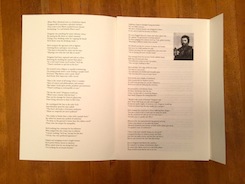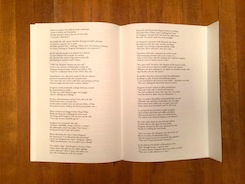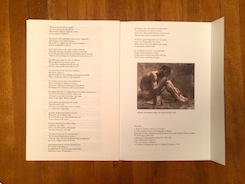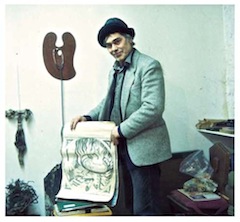Bellaart published Williams for the first time in 1975 (Manifestoes/Manifesten, an anarchist’s pamphlet). That year an essay by Williams also appeared in Beiles’s Sacred Fix. Ever since, Williams’s poems have continued to pour forth in a torrent of separately published cards, many collected in portfolios such as American Porn (2009) and Was Moby Dick Behind 9/11? (2012). At the same time Williams’s chapbooks have been singularly brilliant achievements: Harold Pinter: A Portrait (2014); My Dad and My Uncle (2014); Burroughs in London (2014); and Of Dylan and His Deaths (2015).
Two of the items that came in the package, again by Williams, were “Anarchy’s First Mention” (the folio shown above) and “The Copulation of Angels,” a larger-than-usual card, shown here:
When Milton spoke of the “copulation of angels”And Lear said, “Let copulation thrive!”
They were praising the way that the life-force
Overcomes death with love’s sexual desire.
“There’s little else that life can supply,”
Said John Wilkes, the people’s tribune,
“But a few good fucks and then we die.”
Whereupon our dust’s in continuous motion . . .
And who can prove that we don’t live beyond the grave
With spiritualized selves enjoying vibrant spasms —
Whilst other-worldly beings cluster round us to arouse usIn a transcendent land of perpetual orgasms?
“The Genitals are Beauty,” proclaimed William Blake
And, when they merge in love’s fiery fever,
It’s hard not to think that all’s right with the world;
that these sensations will go on forever.
Heathcote Williams March 2016
The package’s most remarkable item, though, also by Williams, and certainly the most ambitious, was “DIOGENES OF SINOPE: Proto-Anarchist and First Citizen of the World,” a narrative poem produced as a large (12.75″x16.5″) eight-page folio with illustrations and footnotes. Printed on Canson Dore paper for the cover and Saunders Demy Laid paper for the interior, the poem begins . . .
I dreamed I saw DiogenesIn a world reduced to rubble,
And the founder of the Cynics grinned
Through his stench and unkempt stubble.
The end of the world resembled the dump
Where he’d lived in a barrel amongst dogs —
Scavenging scraps on the outskirts of Athens
And making fun of both men and the Gods.
Plato described the wild philosopher
As a maddened version of Socrates.
“It’s not that I’m mad,” Diogenes replied,
“My head’s just different from yours.”
“The Saunders I have lugged around with me for the last 40 years or so,” Bellaart tells me. “The English painter Peter Blake gave me two reams in the early ’70s. Precious stuff! And that’s Heathcote in the barrel.” Put there like Diogenes, it should be noted, by the illustrator Elena Caldera’s digital magic.
(Click the images below to enlarge them for a closer look.)



Full disclosure: I’ve been a beneficiary of Bellaart’s publishing program. We collaborated on two projects together: Carl Weissner’s Le Regard d’Autrui, brought out as a posthumous chapbook in 2012, the year he died; and Norman O. Mustill’s Cuisine Rapide, a portfolio of collages, in 2013, not long before he died. Bellaart also put two chapbooks of my own on his roster: Ticket to New Jersey: A Portrait of Nelson Algren (2014) and Portraits: Williams S. Burroughs, Godfrey Reggio, Norman Mailer (2015), along with a portfolio of poems, Errato (2015).
Finally, it should also be noted that Bellaart is an enemy of perfection. His Cold Turkey productions are idiosyncratic artifacts. In look and feel they may tempt perfection, but imperfection is a value he cherishes with the same intensity that he cherishes taking risks.

!['Anarchy's First Mention' [Cold Turkey Press, 2016]. It measures 8.25 inches x 12.5 inches and opens to 8.25 inches x 16.5 inches. CLICK TO ENLARGE.](http://www.artsjournal.com/herman/wp/wp-content/uploads/2016/11/Anarchy-frontenh240.jpg)
!['Anarchy's First Mention' [Cold Turkey Press, 2016] by Heathcote Williams (in his handwriting) 'Anarchy's First Mention' [Cold Turkey Press, 2016] by Heathcote Williams (in his handwriting) 'Anarchy is first mentioned by Erasmus / In a collection of proverbs in 1539, / where he speaks of a 'liberty of the multitude' / and idea that to many sounded fine. / Four centuries later an anarchist army / Would defeat Franco's fascist militia. / A Barcelona veteran said, 'Anarchismo e amore. That was how we helped build utopia.'](http://www.artsjournal.com/herman/wp/wp-content/uploads/2016/11/Anarchy-middle-benh750.jpg)

!['The Copulation of Angels' [Cold Turkey Press, 2016] by Heathcote Williams (in his handwriting). It measures 8.25 inches x 12.5 inches. CLICK TO ENLARGE.](http://www.artsjournal.com/herman/wp/wp-content/uploads/2016/11/Copulation-of-Angels-frontenh362.jpg)
!['Diogenes of Sinope: Proto-Anarchist and First Citizen of the World' by Heathcote Williams [Cold Turkey Press, 2016] CLICK TO ENLARGE.](http://www.artsjournal.com/herman/wp/wp-content/uploads/2016/11/DIOGENESE-front-362.jpg)